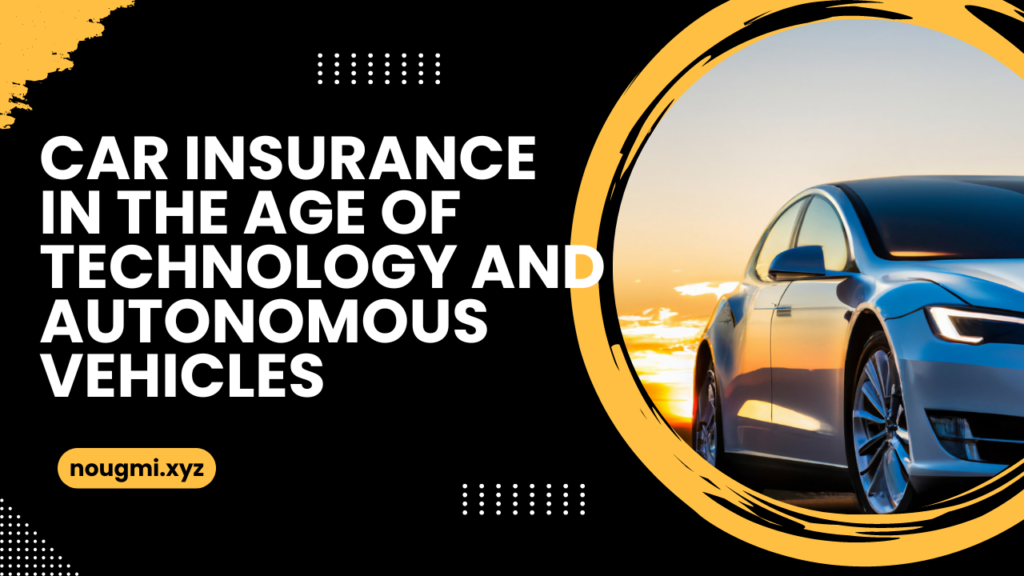Introduction
The car insurance industry is undergoing a significant transformation driven by advancements in technology, data analytics, and changing consumer behaviors. Simultaneously, the advent of autonomous vehicles (AVs) promises to revolutionize the automotive industry, offering safer roads and enhanced mobility. This combined guide explores the advanced topics in car insurance, including telematics, artificial intelligence (AI), usage-based insurance (UBI), blockchain technology, and the profound impact of AVs on risk assessment, liability, premium structures, and the overall insurance landscape.
The Role of Telematics in Car Insurance
What is Telematics? Telematics involves the use of telecommunications and informatics to monitor and collect data on driving behavior. Devices or apps equipped with GPS and other sensors track various aspects of driving, such as speed, acceleration, braking, and location.
Impact on Car Insurance Telematics has revolutionized car insurance by enabling insurers to offer personalized policies based on individual driving habits. This approach, known as usage-based insurance (UBI), allows safer drivers to benefit from lower premiums, while riskier drivers are charged more accurately based on their behavior.
Benefits of Telematics
- Risk Assessment: Insurers can more accurately assess the risk of individual drivers, leading to fairer pricing.
- Accident Prevention: Real-time feedback and coaching can help drivers improve their habits, potentially reducing accidents.
- Claims Management: In the event of an accident, telematics data can provide detailed insights into the incident, facilitating quicker and more accurate claims processing.
Challenges of Telematics
- Privacy Concerns: The continuous monitoring of driving behavior raises issues about data privacy and how this information is used.
- Data Security: Protecting the vast amounts of data collected from cyber threats is a significant concern for insurers.
Artificial Intelligence and Machine Learning in Car Insurance
Enhancing Underwriting Processes AI and machine learning algorithms are transforming the underwriting process by analyzing vast datasets to identify patterns and predict risks more accurately. This enables insurers to develop more precise pricing models and streamline the application process.
Claims Processing and Fraud Detection AI is also improving the efficiency of claims processing. Automated systems can quickly assess damage using image recognition technology, estimate repair costs, and approve claims. Furthermore, AI-powered fraud detection systems can analyze claims data to identify suspicious patterns, reducing fraudulent claims and saving insurers millions of dollars.
Customer Service and Personalization Chatbots and virtual assistants powered by AI provide 24/7 customer support, handling routine inquiries, and assisting with policy management. AI also allows for personalized customer experiences by recommending tailored insurance products based on individual needs and preferences.
Challenges of AI in Car Insurance
- Bias and Fairness: AI models can inadvertently perpetuate biases present in the data they are trained on, leading to unfair pricing or treatment of certain groups.
- Transparency: Ensuring that AI-driven decisions are transparent and explainable to customers is crucial for maintaining trust.
Usage-Based Insurance (UBI)
What is Usage-Based Insurance? Usage-based insurance (UBI) refers to insurance policies that base premiums on the actual usage and driving behavior of the insured vehicle. This approach contrasts with traditional insurance models that rely on historical data and generalized risk factors.
Types of UBI Models
- Pay-As-You-Drive (PAYD): Premiums are based on the number of miles driven.
- Pay-How-You-Drive (PHYD): Premiums are influenced by driving behavior, such as speed, acceleration, and braking patterns.
- Pay-As-You-Go (PAYG): A combination of PAYD and PHYD, where both mileage and driving behavior impact the premium.
Advantages of UBI
- Fair Pricing: Drivers are charged based on their actual driving behavior, leading to more accurate and fair pricing.
- Incentives for Safe Driving: UBI encourages safer driving habits by rewarding good behavior with lower premiums.
- Environmental Benefits: By promoting reduced mileage, UBI can contribute to lower carbon emissions and less traffic congestion.
Challenges of UBI
- Implementation Costs: Installing telematics devices and developing the necessary infrastructure can be costly for insurers.
- Consumer Acceptance: Some drivers may be reluctant to adopt UBI due to privacy concerns or resistance to change.
Blockchain Technology in Car Insurance
What is Blockchain? Blockchain is a decentralized digital ledger technology that securely records transactions across multiple computers. Its transparency, security, and immutability make it an attractive solution for various industries, including insurance.
Applications in Car Insurance
- Smart Contracts: Blockchain enables the use of smart contracts, which are self-executing contracts with the terms of the agreement directly written into code. These can automate claims processing, reduce administrative costs, and speed up payouts.
- Fraud Prevention: Blockchain’s transparency and immutability help prevent fraud by ensuring that all transactions and claims are recorded and cannot be altered.
- Customer Verification: Blockchain can streamline the process of verifying customer identities and driving histories, reducing the risk of identity theft and fraud.
Challenges of Blockchain
- Scalability: Current blockchain technology faces challenges in handling a large volume of transactions quickly.
- Regulatory Uncertainty: The regulatory landscape for blockchain technology is still evolving, which can create uncertainty for insurers looking to adopt it.
The Rise of Autonomous Vehicles
What are Autonomous Vehicles? Autonomous vehicles, also known as self-driving cars, are equipped with advanced sensors, cameras, radar, and artificial intelligence (AI) systems that enable them to navigate and operate without human intervention. These vehicles are designed to perform various driving tasks, from steering and braking to lane-keeping and parking, with minimal or no human input.
Levels of Autonomy The Society of Automotive Engineers (SAE) defines six levels of vehicle automation, ranging from Level 0 (no automation) to Level 5 (full automation). Each level represents a step towards greater autonomy, with Level 5 vehicles capable of operating independently under all conditions.
Current State of Autonomous Vehicles While fully autonomous vehicles (Level 5) are not yet widely available, significant advancements have been made in Levels 2 and 3, where vehicles can perform certain driving tasks but still require human supervision. Companies like Tesla, Waymo, and Uber are at the forefront of AV development, conducting extensive testing and pilot programs.
Changing Risk Landscape
Reduced Human Error Human error is a leading cause of traffic accidents, accounting for approximately 94% of crashes. Autonomous vehicles, with their advanced perception and decision-making capabilities, have the potential to significantly reduce accidents caused by driver error. This shift could lead to fewer claims and lower overall accident rates, fundamentally altering the risk landscape for insurers.
New Types of Risks While AVs promise to reduce human error, they introduce new types of risks, such as software malfunctions, cybersecurity threats, and system failures. Insurers will need to develop new risk assessment models that account for these technological vulnerabilities. Additionally, the complexity of AV technology means that when accidents do occur, they may involve higher repair costs due to the need for specialized parts and expertise.
Data-Driven Insights Autonomous vehicles generate vast amounts of data through their sensors and communication systems. Insurers can leverage this data to gain deeper insights into driving behavior, vehicle performance, and accident causation. By analyzing this data, insurers can develop more accurate risk profiles and offer personalized insurance products tailored to individual driving habits and vehicle usage patterns.
Liability and Legal Considerations
Shifting Liability The advent of autonomous vehicles shifts the focus of liability from the driver to the vehicle manufacturer and software developers. In traditional car insurance models, the driver is primarily responsible for accidents. However, with AVs, liability may rest with the entities that design, manufacture, and maintain the vehicle’s autonomous systems.
Product Liability As AV technology advances, product liability will become a critical issue. Manufacturers and software developers may be held accountable for accidents resulting from design flaws, software bugs, or inadequate maintenance. Insurers will need to navigate complex legal frameworks to determine liability and apportion fault accurately.
Regulatory Challenges The regulatory landscape for autonomous vehicles is still evolving. Governments and regulatory bodies are developing frameworks to address the unique challenges posed by AVs, including safety standards, data privacy, and liability issues. Insurers must stay abreast of regulatory developments and adapt their policies and practices accordingly.
Transforming Insurance Models
Premium Structures The reduction in accidents and claims due to autonomous vehicles may lead to lower premiums for consumers. However, the introduction of new risks and higher repair costs could offset these reductions. Insurers may adopt usage-based insurance (UBI) models that consider factors such as miles driven, driving environments, and vehicle maintenance.
New Insurance Products The emergence of AVs will drive the creation of new insurance products tailored to the unique risks associated with autonomous driving. For example, insurers may offer policies that cover software updates, cybersecurity breaches, and system failures. Additionally, hybrid policies that combine traditional coverage with specialized AV coverage may become more prevalent.
Fleet Insurance As autonomous vehicle technology matures, we may see a rise in shared mobility services and autonomous vehicle fleets. Insuring these fleets will require innovative approaches to risk assessment, pricing, and claims management. Fleet insurance policies may include provisions for ride-sharing, vehicle maintenance, and liability coverage for passengers.
Opportunities and Challenges
Opportunities
- Enhanced Safety: The potential for AVs to reduce accidents and save lives presents a significant societal benefit. Insurers can play a crucial role in promoting the adoption of AV technology by offering incentives for safer vehicles.
- Data Utilization: The wealth of data generated by AVs provides insurers with valuable insights for underwriting, pricing, and claims management. Advanced analytics and AI can help insurers extract meaningful patterns and trends from this data.
- Innovation and Collaboration: The transition to autonomous vehicles will drive innovation in the insurance industry. Insurers can collaborate with automakers, technology companies, and regulators to develop comprehensive solutions that address the unique challenges of AVs.
Challenges
- Uncertainty: The rapid pace of technological advancement and regulatory changes creates uncertainty for insurers. Developing accurate risk models and pricing strategies in this dynamic environment will be a significant challenge.
- Cybersecurity: As vehicles become more connected, the risk of cyberattacks increases. Insurers must develop robust cybersecurity policies and protocols to protect against data breaches and system hacks.
- Public Perception: Building consumer trust in autonomous vehicles is essential for widespread adoption. Insurers can contribute by educating the public about the safety benefits of AVs and offering transparent, easy-to-understand insurance products.
The car insurance industry is at the cusp of a technological revolution. Innovations such as telematics, AI, UBI, and blockchain are reshaping how insurance is priced, sold, and managed. At the same time, the rise of autonomous vehicles heralds a new era for car insurance, with the potential to significantly reduce accidents and enhance road safety while introducing new risks and challenges. By leveraging data-driven insights, embracing innovation, and adapting to evolving regulatory frameworks, the insurance industry can navigate this transformation and continue to provide essential protection for drivers in the age of autonomy. As the landscape continues to evolve, staying informed about these trends and embracing change will be key to success in the ever-changing world of car insurance.


